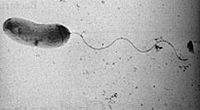Vibrio cholerae
 | ||||||||||||||
| Scientific classification | ||||||||||||||
| ||||||||||||||
| Binomial name | ||||||||||||||
| Vibrio cholerae |
Vibrio cholerae is a Gram-negative, curved rod-shaped bacterium that has a single polar flagellum. It is an aerobic organism and thrives best in alkaline media, The organism causes a major epidemic gastrointestinal disease, cholera.
Current Research
Multivalent drug design and inhibition of cholera toxin by specific and transient protein-ligand interactions.Liu J, Begley D, Mitchell DD, Verlinde CL, Varani G, Fan E.Department of Chemistry, University of Washington, Seattle, WA 98195, USA. 2008 May;71(5):408-19. Epub 2008 Mar 27.
This research is studying how to inhibit the cholera toxin B subunit through precise and transient protein-ligand communication by creating a multivalent drug designed for this purpose. [2]
Is HIV infection associated with an increased risk for cholera? Findings from a case-control study in Mozambique. Von Seidlein L, Wang XY, Macuamule A, Mondlane C, Puri M, Hendriksen I, Deen JL, Chaignat CL, Clemens JD, Ansaruzzaman M, Barreto A, Songane FF, Lucas M. International Vaccine Institute, Seoul, Korea. Trop Med Int Health. 2008 Mar 6
In this study, researchers are focusing on the possible association between cholera and HIV infection. This study was performed in Sub-Saharan Africa where both cholera and HIV are highly abundant diseases.[3]
Does an L-glutamine-containing, glucose-free, oral rehydration solution reduce stool output and time to rehydrate in children with acute diarrhoea? A double-blind randomized clinical trial. Gutiérrez C, Villa S, Mota FR, Calva JJ. J Health Popul Nutr. 2007 Sep;25(3):278-84.
This study observed the effects of different oral rehydration solutions administered for the treatment of cholera. Instead of rehydration with glucose, it is replaced by L-glutamine (L-glutamine ORS). Researchers then compared the amount of time it took for the reduction of diarrhea and rate of rehydration between the two versions, the standard Oral Rehydration Solution ORS and L-glutamine ORS.[4]
- ↑ Vibrio cholerae: Genomics and Molecular Biology. Caister Academic Press Edited by Edited by: Shah M. Faruque and G. Balakrish Nair International Centre for Diarrhoeal Disease Research, Dhaka-1212, Bangladesh and National Institute of Cholera and Enteric Diseases, Beliaghata, Kolkata - 700 010, India. Published July 2008.
- ↑ http://www.ncbi.nlm.nih.gov/pubmed/18373548?ordinalpos=5&itool=EntrezSystem2.PEntrez.Pubmed.Pubmed_ResultsPanel.Pubmed_RVDocSum
- ↑ http://www.ncbi.nlm.nih.gov/pubmed/18331384?ordinalpos=11&itool=EntrezSystem2.PEntrez.Pubmed.Pubmed_ResultsPanel.Pubmed_RVDocSum
- ↑ http://www.ncbi.nlm.nih.gov/pubmed/18330060?ordinalpos=12&itool=EntrezSystem2.PEntrez.Pubmed.Pubmed_ResultsPanel.Pubmed_RVDocSum
